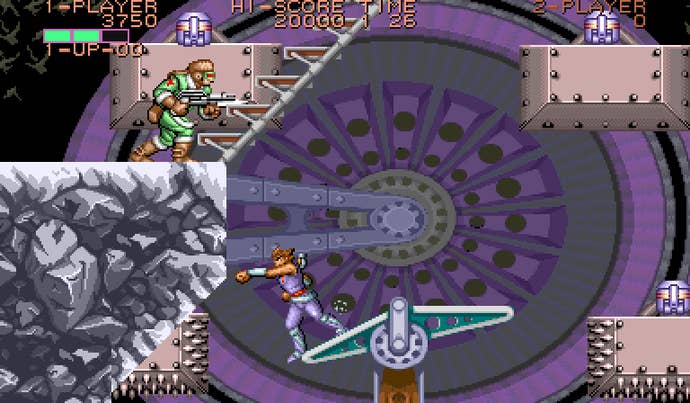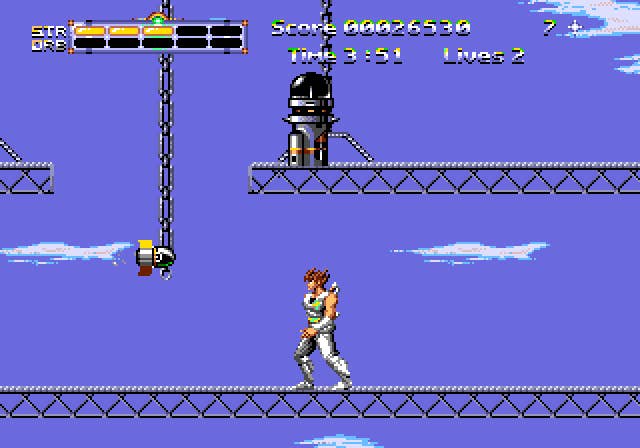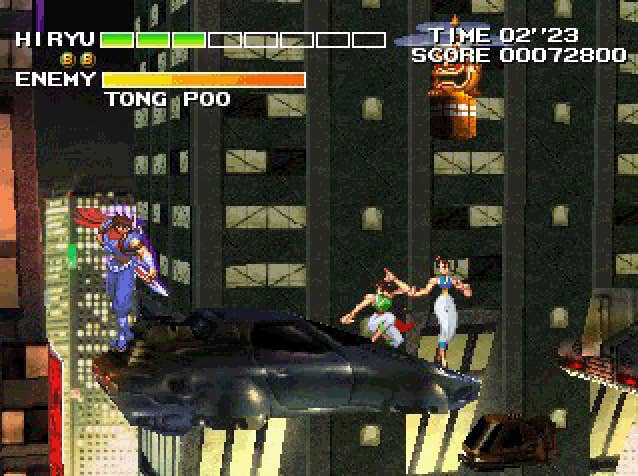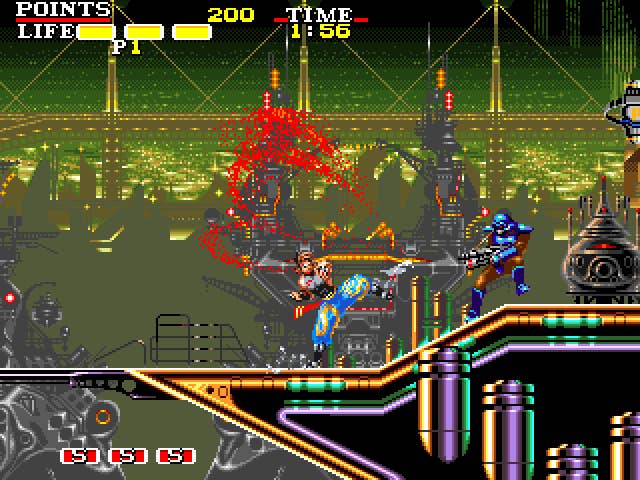Strider's Uphill Battle
The future's coolest ninja is making his comeback via a stylish high-definition reboot. But can he escape the unfortunate gravity of history?
This article first appeared on USgamer, a partner publication of VG247. Some content, such as this article, has been migrated to VG247 for posterity after USgamer's closure - but it has not been edited or further vetted by the VG247 team.
Yesterday, Capcom announced Strider HD, the first new chapter in the classic series since 2000's Strider 2. Best known these days for his cameo appearances in the likes of Marvel Vs. Capcom, Strider's protagonist Hiryu sometimes seems like gaming's Boba Fett: A cool-looking character with a fanbase greatly disproportionate to his actual screen time.
As a fan of the series since its 1989 arcade debut, I want to be excited about this. On the other hand, as a realist, I know better than to get excited. I was initially concerned about the involvement of developer Double Helix -- a company that undoubtedly employs talented people who whose work to date nevertheless commands a Metacritic average of roughly 58 out of 100 -- but the fact that Capcom's internal staff is working hand-in-hand with the studio should make a difference. The promising Spark-developed Lost Planet 3 suggests that Capcom may be capable of coaxing good work out of unreliable developers, so maybe Strider HD will overcome its co-creators' pedigree and excel.
Of much greater concern, however, is the pedigree of the Strider series itself. Yes, the original arcade game was utterly mind-blowing in its day and still offers 30-40 minutes of quality entertainment. But it's the outlier in its own legacy -- the exception. Everything else to bear the name Strider ranges from mediocre to downright wretched. Can Strider HD shake off the oppressive yoke of its own history to be worthwhile?
The announcement trailer seems fairly promising, though a close examination reveals some potential problems. Hiryu looks the part with his forward-leaning run and massive Cypher laser sword, but his robotic animation transitions make the actual controls look stiff. More annoyingly, the game appears to revolve heavily around parrying and countering tiny projectiles, but the screen is a mess of lighting effects that obscure many of the fine details players are meant to interact with. The original Strider managed to be flashy without compromising the action, something its follow-ups have often failed at; at first glance, Strider HD definitely runs the risk of falling into that same trap. The fact that they've nonsensically replaced Hiryu's scarf with a frickin' laser scarf for no reason other than to have an excuse to add one more glowing effect to the already overloaded screen doesn't fill me with confidence.
Still, while Strider may be known best for its arcade incarnation, the franchise was actually conceived as precisely that: A franchise. Capcom strove from the beginning to create a multimedia sensation with Strider, and they developed the arcade game in parallel with both a serialized comic and an NES game. In fact, the NES version seems to offer more of its DNA to Strider HD than the coin-op release, as the new adventure seems to have been built with a Metroidvania-inspired non-linear structure -- something the NES game attempted, uniquely within the entire franchise, though it failed to implement the idea quite as smoothly as one might hope.
It's a little strange that Capcom would look to the NES Strider for inspiration, given that the game was never published in Japan, wasn't terribly good, and had a completely different story than any other entry in the series (tying in with the manga rather than focusing on Hiryu's battle against Meio, aka the Grandmaster). Strider HD takes its looks and plot line from the arcade game, but its back-and-forth design looks like an attempt to make good on the botched NES project. Good on them if they can pull it off.
But to date, no one has managed to recapture the magic of the original arcade classic -- not even Capcom. The NES game was a glitchy, sluggish mess that could have been genius with a little more refinement. Strider's PC Engine version added an extra level that not only stuck a desert inexplicably between the snowy cityscape of Kazakh S.S.R. and the icy wastes of Siberia (spoiling the sleek narrative progression of the adventure) but also lacking the breakneck pace and creativity of the rest of the game.
Maybe that's the element that everyone fails to capture: Strider was conceived from start to finish as a self-contained story. Its presentation (random snatches of interstitial dialogue in a melange of languages) doesn't lend itself to easy interpretation with its fever-dream surreality, but the gist is: Hiryu infiltrates a Soviet state, assassinates its leader, escapes through Siberia, learns of a space station called the Third Moon where the tyrannical Meio pulls the strings, journeys to the Third Moon, and dodges Meio's bizarre ability to spawn flying piranhas long enough to kill the would-be ruler and free Earth from his machinations. The entire game is structured as a simple action movie -- deliberately so, in the words of its director -- with each and every screen meant to feel like a scene from a thrilling anime and refusing to give the player a chance to stop and catch their breath. In a sense, Strider helped pioneer the perpetual, invisible hand-at-your-back style popularized by Call of Duty: Modern Warfare, which makes it ever so slightly ironic that Strider HD is one of Capcom's few upcoming games that isn't eagerly mimicking Call of Duty.
Disappointingly, Strider's sequels did an even worse job of capturing this narrative essence than the alternate versions of the original game. Strider's first sequel came courtesy of another Western developer, Tiertex. In the words of our esteemed editorial director Jaz Rignall, it was "pants": Filled with recycled assets that managed to make the source material look bland and lifeless, bogged down by wretched play control, and lacking anything resembling good or interesting level design, Tiertex's Strider II lived up to its subtitle. That is, it was a Journey Into Darkness for the franchise.



The real Strider 2 -- produced by Capcom several years later as they wisely pretended the Tiertex game had never happened -- helped pull the franchise back from the abyss, but it still fell short of the high standard of the original. Its problems, I think, stemmed more from technical constraints and Capcom's uncertainty about how to position the game. While Strider 2 featured lots of interesting scenes, overall it lacked the fluidity and cohesion of its predecessor; Capcom built the game around the PlayStation hardware with its limited memory, so instead of presenting stages as continuous obstacle courses they had to break each stage into lots of tiny chunks divided by loading screens. The result was jarring and choppy. Worse, the industry in 2000 was hardly friendly to 2D, arcade-style action games, so there's an undercurrent of second-guessing that runs beneath the surface of Strider 2 and keeps the game from realizing its full potential.
All of this is not to say the potential for a great new game doesn't exist in Strider. On the contrary, there have been some pretty solid Strider sequels over the years... but none of them have borne the name Strider. Atlus -- you know, the Shin Megami Tensei people -- completely ripped off Capcom with a Super NES game called Run Saber. While it didn't look quite as slick as Strider's arcade incarnation, in a lot of ways it represented a proper evolution of that game's ideas; it offered cooperative multiplayer, an expanded arsenal of skills, and maintained the brisk, story-telling design aesthetic of Strider at its best. Why Atlus decided to mimic Strider so slavishly remains a mystery, but they did a damn fine job of it.



A purer strain of imitation can be found in several follow-ups by the arcade game's key designer, Kouichi "Isuke" Yotsui. In the mid-'90s, he collaborated with developer Mitchell to create Osman (aka Cannon Dancer), a game best described as "Strider with martial arts." More colorful and more complex than Strider but faithful to its spirit, Osman languished in obscurity until fairly recently as game historians began to dig into Strider's past. Osman also became even more visible when Isuke worked with feelplus and Square Enix to create Moon Diver, a 2011 downloadable title that recaptured much of Strider's essence but fell victim to its dual nature as both a solo and multiplayer game.
That's a lot of baggage for Strider HD to shrug off. Ultimately, the proof is in the playing, so damning or praising the game at this point (when all we've seen is a demo video) seems premature. Like every other Strider fan, I'd love nothing more than a sequel that properly upholds the original game's legacy, and I appreciate the fact that Double Helix and Capcom appear to be trying to use the arcade game's spirit to make good on the interesting but flawed structure of the NES title.
At the same time, Strider has quite a legacy of disappointment behind it, and this generation has demonstrated a rough track record in its attempts to revitalize classic franchises. Heck, Capcom breaks our hearts as often as it fills them with joy. I want Strider HD to fall in line with the amazing Bionic Commando: Rearmed, but I'm well aware that it could just as easily go the way of the questionable HD Bionic Commando sequel... or worse, Mega Man Legends 3. The secret to being a fan of the classics these days: Hope for the best, brace for the worst.


